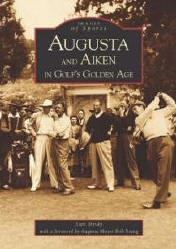Augusta and Aiken in Golf’s Golden Age
History books that focus tightly on particular regions are becoming increasingly popular.
Walk into any independent bookstore or the major chains nowadays, and you are far more likely to see an entire bookcase dedicated to local histories, biographies, and picture books than what would have been available 20 years ago.
Part of the reason for their increasing appeal relates to the often-cited rootlessness so many Americans experience. Millions of people don’t merely move from one home to another within a metropolitan area—they move all over.
Picking up a local history or picture book helps these folks make new connections with their new surroundings.
For others, the local books help confirm their own belief that they did the right thing by not moving. They love their little corner of the world, and these books help confirm their impression.
The other reason for the widening popularity of these books relates to the Internet. With easy online purchase opportunities (such as on this site—hint-hint), millions of readers can easily re-establish their memories of the formerly familiar.
Stan Byrdy’s Augusta and Aiken in Golf’s Golden Age has its own distinctive merits that take the book beyond the local interest category. It should also appeal to golfers with an interest in the history of their sport, regardless of where they live.
Byrdy tapped a wide selection of archived photographs and artwork to produce a 128-page paperback picture book of one of America’s first golf meccas. These two South Carolina/Georgia border towns had several advantages they successfully exploited to entice Northern golfers and vacationers, not least of which included easy rail connections and comparatively mild weather.
Long before the Interstate system, railroads were the only sane way to travel great distances. Rail companies and the burgeoning resort industries mutually benefited from the increasing leisure time opportunities of well-heeled American travelers. The pine-scented hills must have also been enormously appealing to those subjected to the daily smells of not-so-hygienic major cities.
Many of the pictures focus on the hotels that sprang up in the area, whose owners also had the foresight to build a golf course or two for their guests’ enjoyment. For those who take modern-day building safety precautions for granted, these parts of the book will be an eye-opener. Many of these gorgeous wooden hotels burned to the ground. One brochure print in the book shows a replacement hotel with the prominent announcement that the structure is “fireproof.”
That’s a feature you just don’t see in today’s television commercials for the hotel industry.
The golf pictures, of course, are the book’s main attraction, with Bobby Jones and others connected with Augusta National featured in many of the photos. More recent pictures in the book also show a very young Davis Love III and Phil Mickelson, along with other notables from the PGA Tour.
Aiken and Augusta no longer have quite the same tourist appeal that they once did, except of course for Masters Week each spring. Nonetheless, this book is a valuable contribution to the history of golf and American tourism, because it reminds its readers of how the area first came to prominence.
Review date: March 21, 2004


